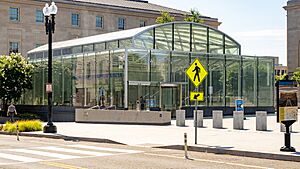National Law Enforcement Museum facts for kids
 |
|

Exterior in 2024
|
|
| Lua error in Module:Location_map at line 420: attempt to index field 'wikibase' (a nil value). | |
| Established | October 13, 2018 |
|---|---|
| Location | 444 E St NW, Washington, D.C. |
| Type | History museum |
| Public transit access | |
The National Law Enforcement Museum is a special place in Washington, D.C. It opened its doors on October 13, 2018. This museum helps visitors learn about law enforcement in America. It uses fun, interactive exhibits and shows real historical items. There are also spaces for learning and research. The museum is mostly underground. It is right next to the National Law Enforcement Officers Memorial. This area, called Judiciary Square, is close to many important courts.
Contents
Museum Design and Layout
The museum was designed by Davis Buckley Architects and Planners. This is the same company that designed the nearby Memorial. The museum has several permanent exhibit areas. It also has one gallery for changing exhibits. The main design work for the permanent galleries was finished by Studio 647. One By Design handled the graphic design.
The building is mostly underground. It has two entrance buildings above ground. Inside, there is about 55,000 square feet of space. The deepest part of the museum is 60 feet below the surface.
Museum History
The idea for the museum began a long time ago. The design was ready in 1991. However, it took many years to get funding and approval. In 2000, the United States Congress officially allowed the museum to be built. The goal was to share the story of law enforcement in the United States. A special area called the "Hall of Remembrance" honors officers who lost their lives.
President Bill Clinton signed the bill into law on November 9, 2000. This allowed planning for the museum to begin. It took five years to get public approval for building at the chosen site.
Construction officially started on October 14, 2010. Important leaders like Attorney General Eric Holder were there. By October 2012, over $58 million had been raised from private donations.
In 2014, a bill was passed to extend the time allowed for construction. This bill was signed on May 16, 2014. It gave the National Law Enforcement Officers Memorial Fund more time to build the museum.
The museum officially opened on October 18, 2018. Like many new places, the museum faced some challenges. It had borrowed money to build. In 2019, it was reported that the museum had trouble repaying this money. The museum has continued to work through these financial challenges.
The museum temporarily closed on March 15, 2020, because of the pandemic. During this time, it offered online learning programs. The museum reopened to visitors on August 27, 2021. It had been closed for 18 months.
Museum Collections
The museum has many interesting items in its collection. These items help tell the story of law enforcement.
- The U.S. Park Police helicopter, called Bell 206 Eagle 1. This helicopter helped during the Air Florida Flight 90 crash.
- A costume from the 1987 movie RoboCop.
- A sweatshirt worn by the character Jack Bauer in the TV series 24.
- Items that belonged to former FBI Director J. Edgar Hoover.
- Evidence from the investigation of the 2002 Beltway sniper incidents.
- Memorabilia about the federal agent Eliot Ness. He was famous during the Prohibition era.
- Handcuffs used in a notable arrest in June 1968.
- A badge, gun, and coin purse that belonged to Pat Garrett. He was a famous lawman in the Old West.
- A badge and Deputy US Marshal commission that belonged to Ted Hinton. He was part of the group that stopped Bonnie and Clyde in 1934.
- A bulletproof vest from around 1930. It was used by a famous gangster, Al Capone.
- An Indiana State Police car.
- Michael K. Neal's Pickup truck.
Museum Exhibitions
The museum has different types of exhibitions. Some are always there, and some change over time.
Permanent Exhibitions
- Being an Officer: This exhibit shows the many different jobs law enforcement officers do. It covers roles like SWAT, corrections, and K9 units.
- Dial 911: Visitors can pretend to be a 9-1-1 Emergency Operator. They answer calls, figure out what's happening, and send officers. You can even hear real 9-1-1 calls.
- History Time Capsules: This area displays historical items from the museum's collection. Visitors learn about officers from different times in American history. This includes colonial times, the Wild West, and modern day.
- History Beat: Six important objects from the collection are highlighted here. Videos and presentations share deep stories about law enforcement history.
- Officers’ Stories: This exhibit shares real stories from officers themselves. These short, true stories give a peek into their daily lives and memorable moments.
- Reel to Real: This display shows items from law enforcement in pop culture. You can see toys, props, and items from famous cop shows and movies. There's also a short film where an actor and a police commissioner talk about how law enforcement is shown on screen.
- Take the Case: Visitors get to be forensic scientists and detectives. They collect clues and learn how cases are built using modern investigation methods.
- Tools of the Trade: This exhibit explores all the gear officers use. Visitors learn how tools have changed over time.
- To Serve and Protect: This section shows how officers work in their communities. It includes first-person accounts from events like 9/11 and the Air Florida Flight 90 rescue. There's also an interactive display called the Web of Law Enforcement. Visitors can follow 60 recent criminal cases from start to finish.
- Hall of Remembrance: This special place honors officers who have died in the line of duty. It shows their names and photos. Visitors can also learn about the Memorial and National Police Week.
Temporary Exhibitions
- Post 9/11: The Evolution of American Law Enforcement: This exhibit focuses on how law enforcement in the U.S. changed after the 9/11 events.
Digital Exhibitions
- Five Communities: This exhibit started in the museum and is now online. It shows how five different police departments work with their communities.
See also
 In Spanish: Museo Nacional de las Fuerzas de Seguridad para niños
In Spanish: Museo Nacional de las Fuerzas de Seguridad para niños

